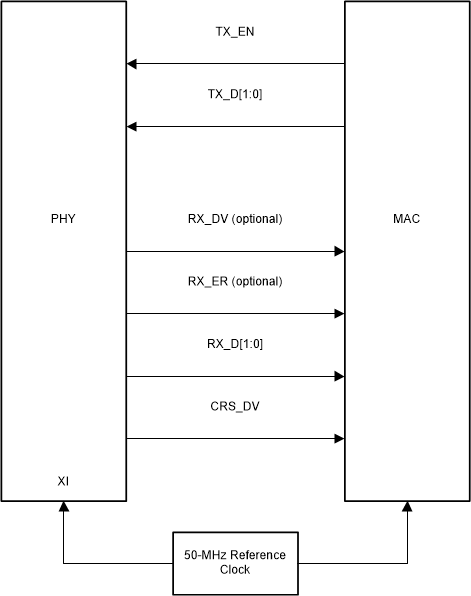ZHCSKM7I December 2019 – August 2025 DP83826E , DP83826I
PRODUCTION DATA
- 1
- 1 特性
- 2 应用
- 3 说明
- 4 模式比较表
- 5 引脚配置和功能(增强模式)
- 6 引脚配置和功能(基本模式)
- 7 规格
-
8 详细说明
- 8.1 概述
- 8.2 功能方框图
- 8.3
特性说明
- 8.3.1 自动协商(速度/双工选择)
- 8.3.2 自动 MDIX 分辨率
- 8.3.3 节能以太网
- 8.3.4 旧 MAC 的 EEE 不支持 802.3az
- 8.3.5 局域网唤醒数据包检测
- 8.3.6 低功耗模式
- 8.3.7 RMII 中继器模式
- 8.3.8 时钟输出
- 8.3.9 媒体独立接口 (MII)
- 8.3.10 简化媒体独立接口 (RMII)
- 8.3.11 串行管理接口
- 8.3.12 100BASE-TX
- 8.3.13 10BASE-Te
- 8.3.14 环回模式
- 8.3.15 BIST 配置
- 8.3.16 电缆诊断
- 8.3.17 快速链路丢失功能
- 8.3.18 LED 和 GPIO 配置
- 8.4 编程
- 8.5 寄存器映射
- 9 应用和实施
- 10器件和文档支持
- 11修订历史记录
- 12机械、封装和可订购信息
8.3.10 简化媒体独立接口 (RMII)
DP83826 采用 RMII 规范(版本号:1.2)中规定的简化媒体独立接口 (RMII)。该接口旨在为第 22 条中指定的 IEEE 802.3 MII 提供一种引脚数更少的替代方案。从架构上讲,RMII 规范在 MII 的任一侧提供了一个额外的调节层,但在没有 MII 的情况下可实现。DP83826 提供两种类型的 RMII 操作:RMII 从模式和 RMII 主模式。RMII 主工作模式下,通过连接 XI 引脚的 25MHz CMOS 级振荡器、连接 XI 与 XO 引脚的 25MHz 晶体为 DP83826 供电。50MHz 输出时钟以 DP83826 为基准,可连接到 MAC。在 RMII 从工作模式下,DP83826 由连接到 XI 引脚的 50MHz CMOS 电平振荡器供电,并且与 MAC 共用同一个时钟。或者,在 RMII 从模式下,PHY 可通过主机 MAC 提供的 50MHz 时钟运行。
RMII 规范具有以下特性:
- 支持 100BASE-TX 和 10BASE-Te
- 从 MAC 到 PHY(或来自外部源)的单个时钟基准
- 提供独立的 2 位宽发送和接收数据路径
- 使用与 MII 接口相同的 CMOS 信号电平
该模式下,发送与接收路径均采用 50MHz 内部基准时钟,每个时钟周期可传输 2 比特数据。
RMII 信号具体汇总如下:
| 功能 | 引脚 |
|---|---|
| 接收数据线 | TX_D[1:0] |
| 传输数据线 | RX_D[1:0] |
| 接收控制信号 | TX_EN |
| 发送控制信号 | CRS_DV |
 图 8-5 使用外部 50MHz CMOS 电平振荡器的 RMII
从模式信令
图 8-5 使用外部 50MHz CMOS 电平振荡器的 RMII
从模式信令 图 8-6 使用来自 MAC 的 50MHz 时钟的 RMII
从模式信令
图 8-6 使用来自 MAC 的 50MHz 时钟的 RMII
从模式信令 图 8-7 RMII 主信令
图 8-7 RMII 主信令TX_D[1:0] 上的数据以 RMII 主模式和从模式下的 50MHz 时钟为基准锁存在 PHY 上。RX_D[1:0] 上的数据以 50MHz 时钟为基准提供。
此外,CRX_DV 可被配置为 RX_DV 信号。它可以通过一种更简单的方法恢复接收数据,而无需将 RX_DV 与 CRS_DV 指示分开。